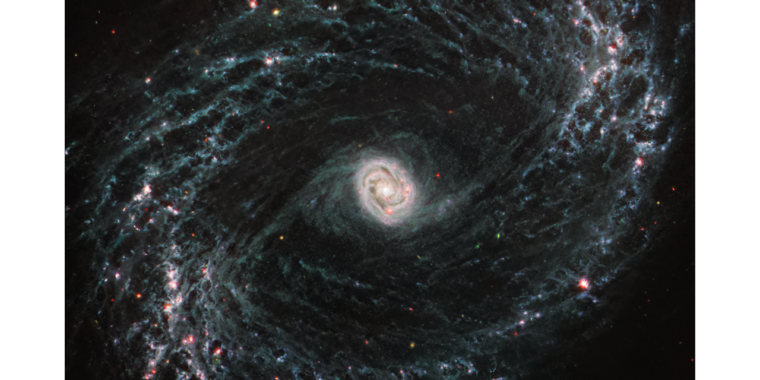Exploring the Galactic Outflows of NGC 4383: A Closer Look
Galaxies are remarkable entities that extend far beyond their visible boundaries. Take galaxy NGC 4383, for example, a cosmic formation that boasts a gas outflow spanning an impressive 20,000 light-years and weighing more than 50 million Suns. Despite its immense scale, detecting such outflows poses significant challenges due to the need for high-resolution instruments capable of capturing intricate details. These instruments crucially enable the observation of nearby galaxies and offer invaluable insights into the composition and structure of galactic gas outflows.
The MAUVE (MUSE and ALMA Unveiling the Virgo Environment) program is at the forefront of revolutionizing our understanding of galactic outflows. This initiative seeks to unravel the impact of outflows on star formation within the Virgo cluster. Notably, NGC 4383 has captured the attention of astronomer Adam Watts and his team due to the sheer magnitude of its outflow. By examining the elements released into space by NGC 4383, researchers can glean insights into the galaxy’s capacity to either foster or impede the formation of stars. This investigation is essential for comprehending the intricate physics of outflows propelled by stellar feedback and its implications for the broader landscape of galaxy evolution.
The Stellar Dynamics at Play
Stellar feedback is a dynamic process driven by the ejection of radiation, particle winds, and various materials from stars, ultimately culminating in the formation of massive galactic outflows. These outflows, such as the one observed in NGC 4383, originate from starburst events or the explosive demise of massive stars like supernovae. The outflow transports a rich assortment of heavy elements that disseminate into space and may even migrate to other galaxies—a cosmic recycling process of sorts.
Star formation within galaxies hinges on a delicate interplay of processes involving gas accretion, consumption, and ejection. The gravitational collapse of vast gas reservoirs serves as a precursor to star formation, with supernova explosions playing a pivotal role in recycling gas and other essential elements needed for stellar birth. A deficiency in gas reserves could stifle the formation of new stars, underscoring the critical importance of maintaining a balanced gas supply within galactic ecosystems.
Watts and his research team posit that the force driving the expulsion of star-forming gas in NGC 4383 stems from a series of closely spaced supernova events. These cataclysmic occurrences generate expansive bubbles of superheated gas that breach the galactic disk, extending vertically and facilitating the outflow of gas from the galaxy’s core. As this scorching gas mingles with cooler interstellar regions, its gravitational pull amplifies, augmenting the mass and scope of the outflow. Consequently, the depletion of gas reserves due to extensive outflows curtails the potential for star formation within the galaxy.
Unraveling the Mysteries of NGC 4383
NGC 4383’s colossal outflow beckons exploratory endeavors across various wavelengths, from X-ray emissions of hydrogen to optical and infrared observations. The spatial resolution achieved by MAUVE presents a breakthrough in accurately deciphering the complex structure of galactic outflows. Viewing NGC 4383 at a resolution of approximately 261 light-years per pixel unveils a bipolar outflow pattern emanating from the galaxy’s zenith and nadir, shedding light on the outflow’s directional dynamics.
Contrary to expectations, NGC 4383 hosts burgeoning star formation activities along its peripheries. While stellar birth does not occur within the outflow stream, localized regions within the galaxy harbor sufficient gas reservoirs to nurture new stars. These regions, characterized by intense starburst phenomena, exhibit vivid near-UV emissions—an unmistakable sign of active star formation outside the galaxy’s central core.
Still, the origins of NGC 4383’s prodigious outflow remain shrouded in ambiguity. Researchers speculate on whether stellar feedback alone instigated the outflow or if gravitational interactions with neighboring galaxies intensified this cosmic phenomenon. An anomalous disturbance in the galaxy’s gas composition on its eastern periphery hints at a potential celestial encounter with a nearby dwarf galaxy. Notwithstanding these uncertainties, the research team asserts that the outflow predominantly stems from starbursts and supernovae.
Charting the Celestial Frontiers
As investigators delve deeper into NGC 4383’s enigmatic outflow, the realm of galactic exploration promises boundless discoveries. Advancements in telescope technologies and refined spatial resolutions hold the key to unlocking new revelations concealed within the veils of cosmic gas clouds. With each observation and analysis, the intricate tapestry of galactic dynamics unravels, illuminating the fundamental processes that govern star formation and the evolution of celestial entities.
Image/Photo credit: source url





